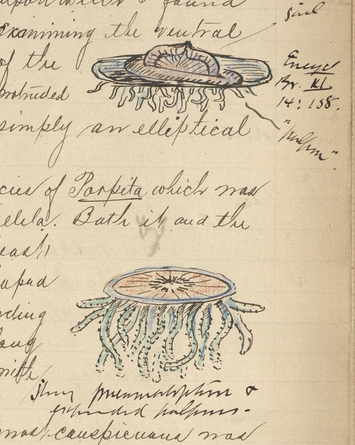In the spring of 1886 a young ensign aboard the U.S.S. VANDALIA on a voyage down the east coast headed towards South America made a short landfall on Staten Island where he spent time with some friends, a Col. And Mrs. Pike, on a hiking expedition to see the local flora and fauna. This ensign, William Edwin Safford, who graduated from the Naval Academy six years earlier, would go on to a distinguished career with the Department of Agriculture as a botanist and eventually have a number of plants named after him. At this young age he exhibited an extraordinary enthusiasm and breadth of knowledge as a naturalist in the U.S. Navy.
One hundred and thirty four years later, the May weather in the northeast U.S. does not lend itself to vernal hikes as it did that year. With that in mind, listed below are a few of the musings of Ensign Safford as he recalls his walk with the learned Pikes, one a herpetologist and the other a nature watercolorist. In addition to the spring plants he mentions, he also writes about the salamanders of Staten Island.
“On the 22nd of May I went with these pleasant friends [Col. And Mrs. Pike] on a collecting excursion to Staten Island near the village of Tomkinson [ed. note, Tompkinsville] where there is a pretty sheet of water called Silver Lake.
In the open woods we found masses of yellow cinque-foil (Potentilla canadensis), the common buttercup (R. bullosis), the little yellow star-grass (Hypoxis erecta) and the pretty bluet (Houstonia coerulia). I collected also the minute Veronica serphyllifolia, and a pretty little yellow flower like a dwarf dandelion – Krigia virginica…
Crossing a field …..we saw great quantities of “Robin’s plantain” (Erigenen bellidifolluim Muhl) in full bloom, we arrived at a little brook, the outlet of Silver Lake. On its banks were thicket of alder; of “black haw”, which was covered with clusters of beautiful white Elder-like flowers (Sambucus); and of the pretty Ericaceons Lencother racemose covered with clusters of fragrant bell-shaped blossoms like miniature lillies-of-the-valley. Two other plants of the same order were in full bloom, the fragrant wild azalea (Rhododendum [Azalea] nudiflorum, L.) and the common huckleberry, and growing from the very margin of the brook were a number of delicate ferns among which of those which I had before seen at Flushing, the Osmundas being far enough advanced to distinguish two species (cinnamomea, and O. regalis). I found also a little white violet with a faint delicate fragrance [viola blanda] which I had before found in New Haven growing abundantly in wet places. It grew here on the very waters edge and near it I found a clump of yellow rag-wort (Senecis aureus, L.) in full bloom. [Of this genus there are but few species in the flora of the North Eastern United States.]”
Safford would go on to describe all manner of plants and animals on this cruise in the VANDALIA. Shown here is but one of the drawings our young naturalist would make along the way. This one in the South Atlantic. Shown is a Velella Velella which lives on the surface of the ocean. A common name today for this is By-the-wind-sailor.

The spring of 2020 is best known today for the ravages the Covid-19 virus is wreaking all over the world. It has forced us all to work from home if we are lucky enough to do so. As part of the stay-at-home workforce is Dr. Paul Goodwin, a valued volunteer in the Collections Research Center at Mystic Seaport Museum. Paul has been going doggedly through all the manuscript material I can throw at him and has managed to keep transcribing day after day. His transcription prowess makes logbooks much easier to read for the rest of us. This journal kept by Ensign Safford is from the collection of the G.W. Blunt White Library and is identified in the collection as Log 123.